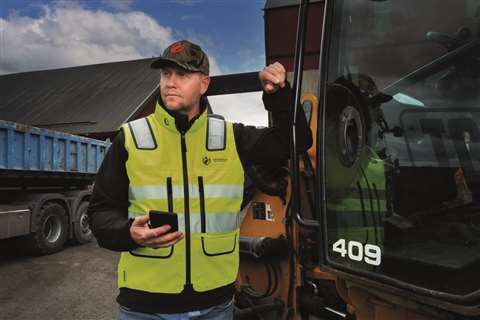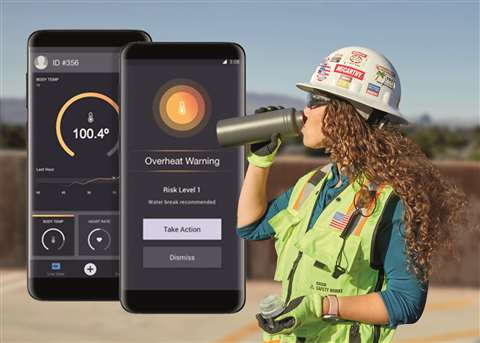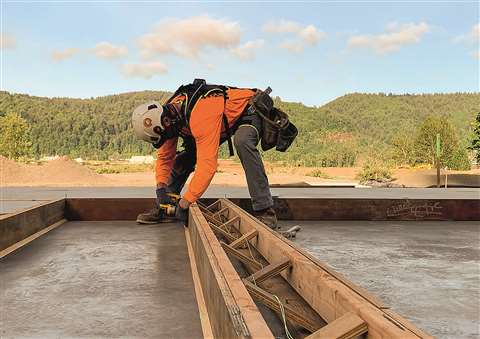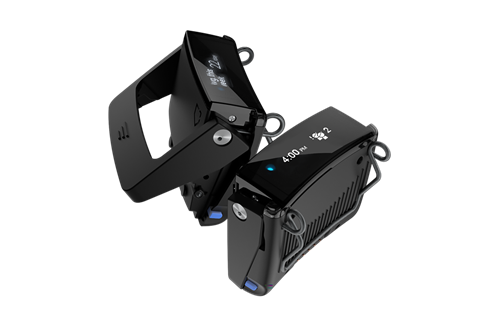Wearing the future: the latest advances in wearable tech
23 December 2022
Worker safety is imperative for every company, but could wearable technology be the solution to mitigate risks on-site? Catrin Jones reports.
 The Atom by XYZ Reality (Photo: XYZ Reality)
The Atom by XYZ Reality (Photo: XYZ Reality)
Wearable technology has an increasing presence on construction sites across the globe as it demonstrates its potential to promote health, safety, connectivity, productivity, and accuracy.
According to a report by the US Chamber of Commerce, only 6% of contractors used wearables on construction sites in 2018 but this number is expected to rise to 23% by 2022 – with wearable technologies such as sensors expected to grow the most.
The report also states that contractors view wearable technologies as one of the top ways to improve safety (83%), workforce management (56%), and productivity (36%). In general, the |US Chamber of Commerce says that about half of all contractors consider key project performance indicators like schedule, budgets and safety to be some of the top benefits of investing in technologies.
How wearable tech is changing health and safety
Wearables have become increasingly popular solutions to enhancing health and safety on-site and a number of employee monitoring systems have been introduced to the market to meet these demands.
The Spot-R fall alert and emergency evacuation system from Triax Technologies monitors employees’ movements to alert safety personnel if the device changes elevation quickly, indicating a fall.
The Scan-Link RFID tags monitor employees’ locations and alert equipment operators of employees behind the machine.
Some smartwatches detect vibration; that technology is used to monitor the ramifications to the body from using power equipment for a long time.
Alerts tell the end-user when power tool use exceeds what the body can safely perform, and this is to prevent hand-arm vibration syndrome (HAVS).
There are also smart helmets that monitor several health elements, such as fatigue, heart rate and stress, so workers and management can modify workers’ activities in ways that promote employee health and job site safety and productivity.
With all of the wearables available in the industry comes an abundance of data and whilst it’s helpful to know how an incident occurred it is also important to draw on the role wearables can have in preventing future incidents.
 Swanholm Technology’s safety vest. (Photo: Swanholm Technology)
Swanholm Technology’s safety vest. (Photo: Swanholm Technology)
Jonathan Fava, president of Scan-Link Technologies, says that using historical data to learn how things happen can be said to be the first step to promoting safety on the job site.
“It’s not enough just to learn how accidents have happened,” says Fava. “The next step is to analyse data to prevent accidents from happening.
With all of the employee detections picked up by the Scan-Link system, managers can identify “hot spots” where machines detect people most frequently.
“Using this data, customers can identify areas where a struck-by incident is most likely to occur.
“Then, customers can make decisions that will decrease the risk of an accident from happening by moving the location of materials, so workers don’t have to walk in a machine’s workspace or by putting up signage warning employees of high-risk areas,” says Fava.
Can AI wearable tech offer multiple solutions?
Wearable technology has the potential to change how we view and deal with health and safety on construction sites.
Notoriously dirty, difficult, and at times, dangerous work, can be mitigated through the use of Artificial Intelligence (AI).
Jonas Svanholm, CEO and founder of Swanholm Technology, believes that AI wearables have the potential to offer companies variable solutions to suit their needs and can go beyond one use. The company has recently entered the wearable market with a connected safety vest.
The product has two main components – a motion-controlled AI and Bluetooth technology – that connects the vest to an app on your phone where you set your emergency contacts. By sensing the movement of the person, the AI enables the vest to light up when exiting a work vehicle cabin such as an excavator or a wheeled loader.
“People are very eager to have this connectivity,” says Svanholm. “They have something that can help them do the work. I think wearables have better usability because of that.
“We have tried to make the vest as flexible as possible so that it gives us the potential to add on different sensors in the future and the Bluetooth and AI enable us to do so.”
 Kenzen devices being used by McCarthy. (Photo: McCarthy Building Companies)
Kenzen devices being used by McCarthy. (Photo: McCarthy Building Companies)
Kyle Hubregtse, CEO of end-end safety monitoring company Kenzen, agrees with Svanholm on how wearables can improve workers’ ability to do their job safely but also says that there is potential for such technology to go beyond just safety.
Kenzen has launched a body heat system that uses physiological monitoring for the prevention of heat injury and death among workers.
The real-time worker heat monitoring system uses a Cloud-based Software as a Service (SaaS) system that includes a wearable device worn by workers on their arms which alerts both the worker and their supervisor when core body temperature is too high.
“Trying to prevent injury and death on site is a number one focus but it’s also about improving the ability to do your work,” says Hubregtse.
“If you’re able to moderate and stop yourself before you overheat or overexert yourself then you’ll be able to do better work. This in turn encourages your mood to improve and how you work with others will increase.”
Hubregtse says that there are many ways to improve productivity around work and rest schedules and mitigate the risks associated with working in hot spells on the construction site throughout the day.
“This helps improve workers’ overall health, so they’re able to moderate differently. They’re able to understand their body differently based on the data and the insights that we give them.”
Assisted reality technology
Wearables are also instrumental in merging realities, which is bringing connectivity, productivity and accuracy to job sites.
Exoskeleton and assisted reality headset manufacturer Real Wear released the second version of their assisted reality headset, the RealWear Navigator 500.
 HeroWear Apex exoskeleton in action. (Photo: Herowear)
HeroWear Apex exoskeleton in action. (Photo: Herowear)
The company says that it is sleeker, lighter and more ergonomic than the previous model (the HMT100) for all-day comfort yet is rugged and durable for use on construction sites and in industrial settings.
It features a modular design, a 48-megapixel camera sensor with enhanced zoom capability, low light performance, and is compatible with more than 200 optimised apps.
“With the Navigator 500, we wanted to provide scale enterprise solutions as part of the digital transformation movement.
“Today, we see the acceleration of digital transformation on the future of work, especially since the pandemic,” says Andrew Chrostowski, chairman and CEO, RealWear Technologies.
Why is wearable technology becoming popular?
Mark Harris, CEO of protective clothing supplier HeroWear, also agrees that the pandemic has accelerated construction’s adoption of new technology.
“There has been a greater push toward valuing people’s quality of life. Along those lines, the Great Resignation has spotlighted the importance of taking care of your employees and understanding the high cost (both fiscally and emotionally) that companies face with high turnover.”
In response to the demand for worker health and safety, HeroWear’s Apex exosuits provide physical assistance to help reduce back strain – a leading factor in the back pain crisis among construction workers says Harris.
“That support also helps fight against fatigue,” adds Harris. “And preventable accidents often occur because a person is fatigued.
“Exosuits like the HeroWear Apex are a practical solution because they comfortably provide physical assistance while maintaining the freedom of movement needed for tasks on a construction site.”
Portable and wearable AR tech
Augmented Reality (AR) is another key innovation that has evolved considerably over the last couple of years. The technology has progressed from simple overlays on portable devices like tablets to engineering-grade wearable devices like safety goggles and XYZ Reality’s AR headset, the Atom.
“The Atom is a specially-designed piece of hardware combining a safety-certified headset, AR displays and in-built computing power,” says David Mitchell, CEO and founder of XYZ Reality.
“This tool provides the protection of a hardhat with the superhuman powers of AR, achieved through high-tech optical displays, showing the versatility of wearable technology.”
 David Mitchell, CEO of XYZ Reality. (Photo: XYZ Reality)
David Mitchell, CEO of XYZ Reality. (Photo: XYZ Reality)
Mitchell says that to get the most out of wearable technology in construction, we must hone in on the challenges facing workers on the ground and think about how to design it to be as easy and safe to use as possible.
“Cutting-edge wearable construction technology like AR-enabled devices provide personnel with new-found agility on site, allowing them to build more safely, with greater accuracy and more collaboratively,” adds Mitchell.
“Bringing Building Information Modelling (BIM) to life in real-time in the field using digital technology like this also bridges communication gaps between teams on and off-site, opening up new ways to collaborate on projects and carry out remote inspections, in the case of AR.”
Ultimately, innovative digital solutions are opening the door to a new era of construction in which architects, engineers and construction workers are connected and supported by the power of technology.
“It’s an exciting time for the industry,” enthuses Mitchell.
“Further investment into wearable technology will help drive this transition to a high-tech future.
“The potential is huge, it’s now about acting and harnessing the tools at our disposal as effectively as possible.”
Looking forward, ongoing research and development, as well as a better understanding of issues in construction and the greater availability of data provided by digital technologies and collaborative software, will help to realise the potential of new technology.
Digitally enabled wearables can seamlessly gather information during operations, and this could provide companies with valuable data for analysis to improve the efficiency of construction in the future.
Do Kinetic wearables reduce injury?
Kinetic, a wearable technology company that fosters safe environments for the industrial workforce, has announced the findings of a new report by Perr & Knight, a US-based actuarial consulting firm, which finds that the Kinetic Reflex wearable technology reduces injury frequency by 50-60% and reduces lost workdays by 72%.
 (Photo: Kinetic)
(Photo: Kinetic)
The Perr & Knight report is said to provide an actuarial analysis of the KINETIC wearable device and its impact on workers’ compensation insurance losses.
The company says that the Kinetic Reflex is wearable technology that detects unsafe postures commonly occurring on the job, such as bending, overreaching, and twisting, that over time lead to injury.
“To get a clear view of the KINETIC wearable device and its impact on workers’ compensation insurance losses, we partnered with an actuarial consulting firm that had proven domain expertise in the property & casualty and accident and health industries,” said KINETIC CEO and Cofounder Haytham Elhawary.
“Perr & Knight was able to take operational data from KINETIC customers and draw a clear line between the deployment of our Reflex wearable technology and reduced injuries and lost workdays.”
The Perr & Knight analysis used Kinetic data from clients of the wearable technology including counts of OSHA recordable incidents, sprains and strains, and days of missed work.
The data is said to have covered more than 15 million hours worked across various industries and over 2.1 million hours of Kinetic wearable hours. The data was aggregated at the monthly level to review metrics over time.
STAY CONNECTED



Receive the information you need when you need it through our world-leading magazines, newsletters and daily briefings.
CONNECT WITH THE TEAM








